Simplify your monthly bill with autopay
Dubois REC’s




from the editor
Goodbye summer
The summer heat is finally starting to cool off, and fall is just around the corner. It’s time to say goodbye to summer and welcome all the new season’s fun activities. I don’t know about you, but I’m ready for sweater weather, football, and bowls of chili.
To celebrate the end of summer, we asked Indiana Connection readers to submit their favorite summer snapshots for our photo contest. We received many great entries. Turn to page 26 to see our winner.
One of my favorite summer photos was taken two years ago during a vacation with my husband’s family to Gatlinburg, Tennessee. Brooks is from a large family, and we try to take a summer vacation every other year to spend time together. It was our daughter Gwen’s first vacation. She was 9 months old at the time, so Brooks carried her in a special backpack while we hiked in the Great Smoky Mountains National Park.

As anyone who has vacationed with small children knows, sleep can be elusive in a new place. About 10 minutes into our hike, Gwen fell asleep and stayed that way until we returned to the car. I guess the sounds of the mountains and the nearby stream made for a great natural sound machine.
Have a great summer photo, but missed the deadline for our contest? I would still love to see it. Send it to me at bdavis@indianaec.org.


Britt Davis Editor bdavis@indianaec.org
On the menu: November: Submit your favorite comfort food recipes, deadline Sept. 1. If we publish your recipe on our food pages, we’ll send you a $10 gift card.
Giveaway: Enter to win a copy of “Peru: Circus Capital of the World” by Kreig A. Adkins. Visit indianaconnection.org/talk-to-us/contests or send your contact information to the address below. The deadline to enter is Aug. 31.
Three ways to contact us: To send us recipes, photos, letters and entries for gift drawings, please use the forms on our website indianaconnection.org; email info@indianaconnection.org; or send to Indiana Connection, 11805 Pennsylvania Street, Carmel, IN 46032.
VOLUME 75 • NUMBER 2 ISSN 0745-4651 • USPS 262-340
Published monthly by Indiana Electric Cooperatives
Indiana Connection is for and about members of Indiana’s locally-owned, not-for-profit electric cooperatives. It helps consumers use electricity safely and efficiently; understand energy issues; connect with their co-op; and celebrate life in Indiana. Over 311,000 residents and businesses receive the magazine as part of their electric co-op membership. The average printed and mailed cost per issue is 54 cents.
CONTACT US: 11805 Pennsylvania Street Carmel, IN 46032
317-487-2220
info@indianaconnection.org IndianaConnection.org
INDIANA ELECTRIC COOPERATIVES OFFICERS: Steve McMichael President
Dr. Richard Leeper Vice President
Jamey Marcum Secretary/Treasurer
John Cassady CEO
EDITORIAL STAFF:
Britt Davis Editor
Mandy Barth Vice President of Communication
Lauren Carman Communication Manager
Ashley Curry Production and Design Coordinator
Holly Huffman Communication Support Specialist
Amber Knight Creative Manager
Kiley Lipps Graphic Designer
ADVERTISING:
American MainStreet Publications Cheryl Solomon, local ad representative; 512-441-5200; amp.coop
Paid advertisements are not endorsements by any electric cooperative or this publication.
UNSOLICITED MATERIAL:
Indiana Connection does not use unsolicited freelance manuscripts or photographs and assumes no responsibility for the safekeeping or return of unsolicited material.
SUBSCRIPTIONS: $12 for individuals not subscribing through participating REMCs/RECs.
CHANGE OF ADDRESS:
If you receive Indiana Connection through your electric co-op membership, report address changes to your local co-op.
POSTAGE:
Periodicals postage paid at Indianapolis, Indiana, and at additional mailing offices.
POSTMASTER:
Send change of address to: Indiana Connection, 11805 Pennsylvania Street, Carmel, IN 46032. Include key number.
No portion of Indiana Connection may be reproduced without permission of the editor.





Human Rocket Skyler Miser was launched from her first cannon at age 11. In this month’s cover story, learn more about how the Peru, Indiana, native was inspired by her circus performer parents to join Ringling Bros.

www.duboisrec.com
CONTACT US
Office: 812-482-5454
Billing Dept.: 812-482-1664
Operations Dept.: 812-482-1188
After Hours: 812-482-5455
Fax: 812-482-7015
CEO AND GENERAL MANAGER
Joe Henson
OFFICE HOURS
7 a.m.–4 p.m., Monday-Friday
7 a.m.–3:30 p.m. for Line Dept.
STREET ADDRESS
1400 Energy Drive Jasper, IN 47546
MAILING ADDRESS
P.O. Box 610 Jasper, IN 47547-0610
EMERGENCY POWER OUTAGES
To report service interruptions, call: 812-482-5454 (during regular hours) or 812-482-5455 (after hours) day or night. Please have your account number ready when reporting outages.
BOARD OF DIRECTORS
Brad Knies, President
Richard A. Wendholt, Vice President
Randall L. Stemle, Secretary-Treasurer
Mark Montgomery
Andy Schwenk
Steve Speedy
David Rudolph
KEY STAFF
Craig Adams
Manager of Finance
Matt Brames
Manager of Engineering
Greg Dilger
Engineering Project Manager
Ruth Hopf
Billing Supervisor
Patrick Lichlyter
Manager of Operations
CUSTOMER SERVICES
Budget billing
SmartHub
Pay by phone 24/7 Drive-thru window Night depository Medical account watch
UNLOCK COMFORT AND SAVINGS
If you’re working on your summer to-dos, consider adding home weatherization to your list. We typically think about weatherizing our homes during winter months when we’re standing next to a chilly window or a drafty exterior door. But weatherizing your home provides comfort and energy savings year-round, especially during summer months when your air conditioner is working overtime.
According to energystar.gov, a home with insufficient insulation and air leaks wastes more than 20% of the energy used to heat or cool the home –– that’s essentially throwing money out the door. Fortunately, most weatherization projects are easy to DIY and can be completed in a day.
The simplest and most cost-effective weatherization strategies include air sealing around windows and exterior doors.
If you have older windows, odds are you have air escaping through tiny cracks and gaps around the frame. Do a quick visual inspection. If you can see any daylight around the frame or the windows rattle easily, you likely have air leaks. Also check for any small cracks around the frame that may not be visible with sunlight.
If you suspect you have leaky windows and plan to apply new caulk, be sure to remove the old caulk and clean the area well before application. Caulking materials vary in strength and properties, but you will likely need a half-cartridge per window.
Silicone caulk is a popular choice and can also be used to seal joints between bathroom and kitchen fixtures. If you have any leftover caulk, use it to seal those areas.
Another effective but simple weatherization project is installing weatherstripping around exterior doors. The most common types of weatherstripping options are V-channel, felt and foam tape. To choose the best type for your home,
consider temperature fluctuations and weather exposure. Most homeowners opt for felt or foam tape; both options are easy to install but will need to be replaced every couple years, depending on wear and tear. Weatherstripping should be installed around the top and sides of the door.
If you see daylight around the bottom of an exterior door, consider installing a door sweep in addition to weatherstripping. Door sweeps are available in aluminum, plastic, vinyl and felt options.
Weatherstripping can also be installed around windows, typically to the sides of a double hung or sliding window, or around the window sash.
If you’re unsure how to install weatherstripping or apply caulk, check out trusted websites like energy.gov for step-by-step instructions and video tutorials.
Another way to improve comfort in your home is adding insulation. While this is a more costly project and requires a professional’s help, it’s an effective way to decrease heat flow, which impacts energy use in winter and summer months. Older homes may need additional insulation to either replace older materials or meet newer efficiency standards. Contact a qualified installation specialist if you suspect your home’s insulation levels are inadequate.
In addition to saving energy, air sealing can help you avoid moisture control issues, improve indoor air quality and extend the life of your heating and cooling system. Weatherize your home to unlock yearround comfort and savings on monthly energy costs.

JOE HENSON CEO and General Manager
Rate schedule
Service charge
Single-phase
$35.50
Three-phase $47
Energy charge
The first 500 kWh at $.10522/kWh
The next 2,500 kWh at $.09772/kWh
All remaining kWh at $.09462/kWh
Power cost tracker
All rate classes
All kWh at $0.008/kWh
Security light
If you have a security light, add:
175-watt mercury vapor
100-watt sodium vapor
100-watt metal halide
70-watt LED
$8.32/month
$7.50/month
$8.75/month
$7.50/month
Electric bills due by the 20th of each month.
Members who pay by the 15th, or pay their bill by auto draft, will be entered in the monthly drawing for a $50 bill credit.
Visit duboisrec.com for easy ways to pay your electric bill online.
The easiest way to win a
$50 bill credit
NEW WINNER EACH MONTH!
It’s easy to enter our monthly $50 drawing! All Dubois REC members who pay their bill by the 15th of the month, using any payment option, will be automatically entered in the $50 monthly drawing. Members who pay by ACH/bank draft and recurring payments are also automatically included in the drawing. (Delinquent payments are not eligible.)
The winner will be notified, and their name will be published here.
JULY’S WINNER:
HOWARD D. ANDERSON, JASPER
A summer experience to remember
Local students attend Camp Kilowatt


typical camp activities like horseback riding, zip lines, high-ropes, swimming and archery while including electrical safety demonstrations, environmental education, and cooperative business education.
Dubois REC Service Anniversaries
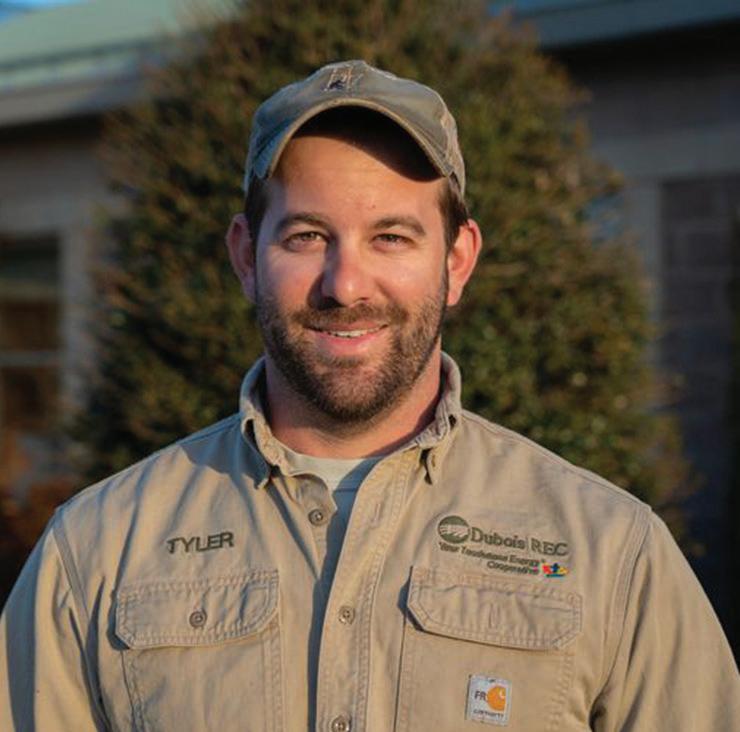

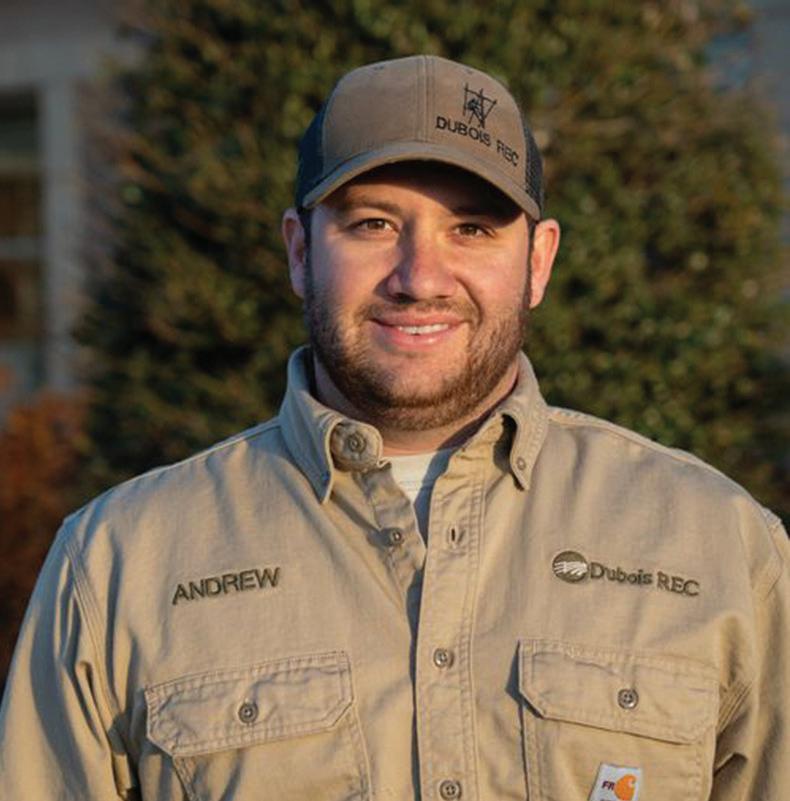
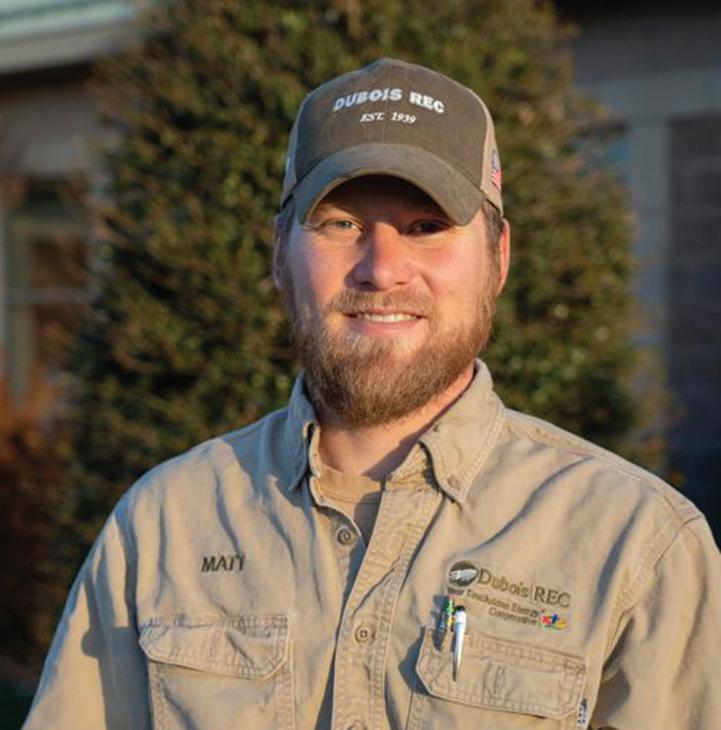
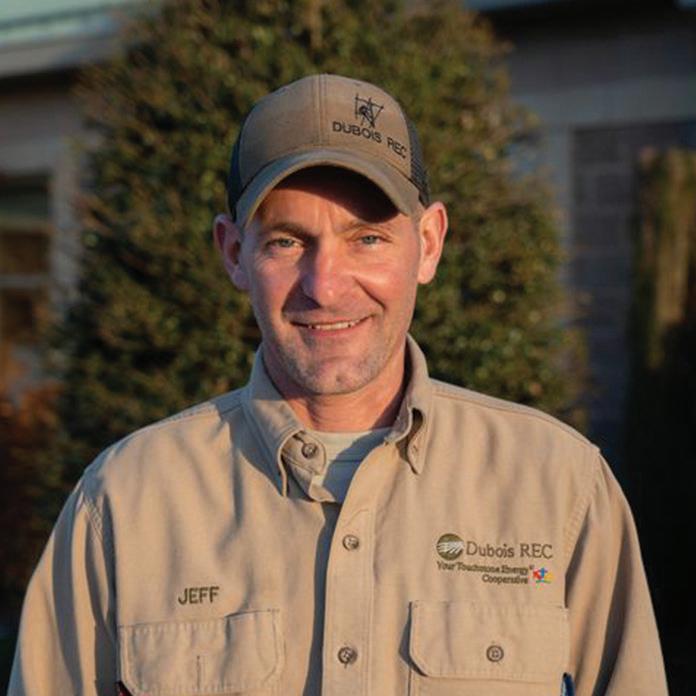
We appreciate the hard work and dedication these line-workers have dedicated to Dubois REC and its members. These five gentlemen represent a combined 45 years of service to our electric cooperative!
NOTICE OF HOLIDAY OFFICE HOURS
5 STEPS FOR SAFE
DIGGING
Working on an outdoor project? Careless digging poses a threat to people, pipelines and underground facilities. Always call 8-1-1 first. Here are five easy steps for safe digging:
1. NOTIFY

2. WAIT
The Dubois REC office will be closed, Monday, Sept. 1 as our employees take a much deserved break for Labor Day.
Call 8-1-1 or make a request online two to three days before your work begins. The operator will notify the utilities affected by your project.
Wait two to three days for affected utilities to respond to your request. They will send a locator to mark any underground utility lines.
3. CONFIRM
UP
ROUND
Do you work with a local non-profit organization or school group that could benefit from an Operation Round Up grant?
The final deadline to submit an application for a grant in 2025 is Oct. 30 at 4 p.m.
Visit our website, duboisrec.com, under the “Community“ menu for more information.
2-3
Confirm that all affected utilities have responded to your request by comparing the marks to the list of utilities the 8-1-1 call center notified.
4. RESPECT
Respect the markers provided by the affected utilities. The markers are your guide for the duration of your project.
5. DIG CAREFULLY
If you can’t avoid digging near the markers (within 18-24 inches on all sides, depending on state laws), consider moving your project location.
Source: call811.com

inseam.
25-28646-1229 28" inseam.
Use code WWC6H3 to get items 25-28637-1229, 25-28646-1229, 25-46335-1229 for $11.99 and get free shipping on your order. Free shipping applies to standard shipping only, not including any additional shipping surcharges. Shipping upgrades additional. Does not apply to clearance. Discount is priced as marked in checkout. Not applicable to gift cards or prior purchases. May not be redeemed for cash or combined with other offers. Returns credited at discounted price. Only applies to in-stock merchandise. Expires 9/30/2025. Order by mail: Woman Within, 500 S. Mesa Hills Drive, El Paso, TX 79912
















BOOT UP CAMP
ELECTRIC DEVICES AND APPLIANCES CAN HELP CREATE A COMFORTABLE CAMPSITE

Many people enjoy escaping town into the great outdoors, though not without energy-driven creature comforts keeping them company. This time of year, many people enjoy getting outside and into nature. It’s the perfect time to camp near the lake, in the woods, or with family and friends. Some campers cannot leave without devices that enhance their experience of nature. It could be something as simple as their phone, while others might bring several gadgets with them. Luckily, technological advancements have provided great options for comfort and power in peaceful, remote spots far from the energy grid. Here are a few ideas to help you enjoy camping with some energized creature comforts.
SOLAR PANEL AND BATTERY KIT
If you take devices or appliances with you, a solar panel and battery kit is a must-have! Campers can use portable batteries to charge cell phones and other small electronics. Some models also come with solar
panels so that the battery can be charged when not in use. While not cheap, larger batteries can be incredibly valuable for powering other devices you may want to use at the campsite.
RECHARGEABLE LANTERN OR LIGHT
Energy-efficient lanterns and flashlights take advantage of LEDs, which shine brighter and use less energy than older generations of flashlights. Solar lanterns are rechargeable during the day so that they can be used again in the evenings or overnight.
COOKING APPLIANCES
Devices such as an induction cooktop offer a unique alternative to campfire cooking. A portable induction cooktop can easily be transported and heat food in a pan. It will need an electrical power source — maybe a larger battery recharged with a solar panel — so check that the power source can meet the cooktop’s watt requirements.
FAN AND AIR MATTRESS
Rechargeable devices can add comfort to your campsite. Some fan models are equipped with rechargeable lithium-ion batteries, many of which can last for hours on a single charge. You can also get a rechargeable air pump to fill an air mattress, adding extra comfort to your tent.
Enjoying the outdoors doesn’t necessarily mean without creature comforts. You can check out a variety of websites to learn about devices that can help you get the most enjoyment from your campsite.

by Brian Hawk Energy Advisor Noble REMC





































county feature
Johnson County
Johnson County is home to Franklin College, one of Indiana’s oldest colleges. Established in 1834, it was initially named the Indiana Baptist Manual-Labor Institute before the Indiana General Assembly renamed it. Notable alumni include Arch West, the marketing executive behind Doritos, and Robert Wise, an Academy Award-winning director and producer of “West Side Story” and “The Sound of Music.”
A SISTER CITY IN BLOOM
Kuji Alley in Franklin honors its sister-city relationship with Kuji, Japan, which began in 1960. The connection began with Franklin College alumna Thomasine Allen, who traveled to Japan in 1915 as a missionary. She taught in several cities before settling in Kuji, where she helped establish Christian institutions, including a kindergarten, hospital, church, and college. In recognition of her impact, the Kuji City Council named Allen an honorary citizen. Today, Kuji Alley celebrates this connection with 800 metal cherry blossoms, 70 Japanese lanterns, a koi fish mural, and a traditional Japanese footbridge.

FRANKLIN’S SILVER SCREEN COMEBACK
The Historic Artcraft Theatre in Franklin was built in 1922 as a silent movie house and Vaudeville venue. From the 1960s through 2000, it operated as the only movie theater in Franklin. After 78 years, the theater closed in May 2000 with a final showing of “Gone with the Wind.” In 2004, Franklin Heritage Inc., a nonprofit dedicated to historic preservation, reopened the theater, restoring the building and operating it as a community-focused venue. Now, the theater features films that are at least 10 years old with a focus on cult classics.


YEAR-ROUND FESTIVAL FUN
Nicknamed “Festival Country,” Johnson County hosts more than 1,000 festivals, concerts, and events annually, from weekly farmers markets to yearly traditions. In August, the Sertoma Club of Greenwood hosts WAMMfest, an annual summer festival celebrating wine, art, music, and microbrews. A little farther south, Bargersville hosts the Harvest Moon Fall Festival on Sept. 20.
COUNTY FACTS
FOUNDED: 1823
NAMED FOR: John Johnson, an Indiana Supreme Court Justice
POPULATION: 170,614
COUNTY SEAT: Franklin
INDIANA COUNTY NUMBER: 41
All photos courtesy of
Country Indiana

SHINING A LIGHT ON YOUNG COMMUNITY LEADERS
Do you know a middle schooler who goes above and beyond to serve their community?
The Youth Power and Hope Awards recognize outstanding young leaders making a difference! Up to five winners will each receive $500 and be featured in an upcoming issue of Indiana Connection.
Encourage your child to apply today! Simply complete the online application and share details about their community service.
Parents, please visit indianaconnection.org/youthpowerandhope to apply and learn more.


or 317-487-2235
Applicants must have a parent or guardian who is a member of an Indiana electric cooperative.
UNDERSTANDING ELECTRIC INFRASTRUCTURE:
STREAMLINING CONNECTIVITY
The essential steps for attaching equipment to REMC electric poles
Utility poles seen along roadsides are commonly called “telephone poles.” However, most poles you see today are owned by the electric utility. In rural areas, pole attachments are critical to expanding broadband internet, telecommunications, and cable services. In communities served by REMCs, third-party providers often seek to attach cables, lines, or other equipment as a cost-effective option for their services.
The process of attaching to REMC-owned poles involves several steps designed to ensure safety, reliability, and joint-use access. Once a contract has been established between the cooperative and the attaching entity, they will move through several steps:
1. APPLICATION AND REVIEW
An attacher, such as an internet service provider, submits an application to the REMC. The application includes detailed maps, pole identification numbers, proposed equipment specifications, and the intended use. The REMC reviews it to ensure it meets engineering standards, safety codes (such as the National Electrical Safety Code or NESC), and internal policies.
2. POLE SURVEY AND ENGINEERING ASSESSMENT
The REMC conducts a field survey and engineering assessment. A pole is evaluated to determine if it can accommodate the new attachment without compromising its structural integrity or safety. The survey checks for adequate space in the pole’s "communications space,” required clearance from existing equipment and lines, and proximity to other utility infrastructure. If the pole is found to be unsuitable, a "make-ready" process is triggered.
3. MAKE-READY WORK
Make-ready work prepares the pole for a new attachment. This may include rearranging existing attachments,

replacing the pole with a taller one, or upgrading supportive hardware. The REMC provides a cost estimate and timeline for this work. Once approved and paid for by the attaching party, the REMC or a licensed contractor completes the necessary work. This phase ensures all attachments meet safety standards and the pole remains stable and functional.
4. ATTACHMENT INSTALLATION
Once the make-ready work is complete, the attaching party can install its equipment. This installation must comply with NESC guidelines, contract provisions, and REMC-specific standards. The REMC may inspect the installation to verify compliance with all standards and ensure it does not interfere with existing utilities.
5. ONGOING MONITORING AND MAINTENANCE
After the attachment is installed, the attacher is responsible for maintaining its respective equipment while the REMC retains the right to inspect, audit, and enforce compliance over time. When new electric poles are installed to replace aging or broken poles, the attacher is required by Indiana law to relocate their lines to the new poles.
The Indiana REMC infrastructure continues to serve as the backbone for essential services, including broadband deployment. This pole attachment procedure ensures public safety, system integrity, and fair access.
Stay in the home you love with a Stiltz Homelift
Our home elevators can t just about anywhere in your home
THE MODERN SOLUTION
A Stiltz Homelift is a safe, attractive, & affordable alternative to stairlifts. It requires no special machine room, and no supporting walls.
ECONOMICAL & FLEXIBLE
A Stiltz Homelift can t just about anywhere in your house. It has a compact footprint, similar in size to a small armchair.
A Stiltz Homelift plugs into a standard home electrical outlet, using less power than a coffee maker.
YOUR FOREVER HOME
Avoid the expense and distress of relocating, or the disruption of adapting

you know?
your home for downstairs living. A Stiltz Homelift helps you live safely and independently in the home you love.
IT’S NEVER TOO SOON
Some Stiltz customers need a Homelift immediately. But others want to “future-proof” their homes for when the stairs become a challenge.
HOMELIFT SPECIALISTS
Stiltz is a world leading Homelift manufacturer, so you’ll be in good hands. Your elevator will be installed and maintained by Stiltz trained professionals who truly care about your freedom.
AARP survey data shows that 77% of adults 50 and older want to remain in their homes for the long term. At Stiltz, we’re here to help you stay in your home you love. It’s easy.
“I can’t imagine what we’d do without it. I wish we had installed our Stiltz Homelift several years ago!”
– Mr. James, Roanoke, VA
• Affordable
• Small Footprint
• Full Safety Features
• Clean, Quiet Operation
• Low Power Consumption
• Freestanding Design
• Wheelchair Accessible
• Carry Laundry or Pets
• Fast Installation
• Full Warranty





CREATE A SAFETY PLAN before planting a tree Five steps to safe digging
Trees can be beautiful additions to a yard, but knowing how to plant one safely can be tricky. While you may think of the potential dangers to yourself when planting a tree, there are also ways you can harm nearby power lines and other trees. Trees growing too close to electrical lines can cause momentary short circuits and flickering lights. When it storms, tree limbs that are too close to power lines can knock them out and threaten your safety.
Look for potential dangers
When planting a tree, consider potential safety issues associated with overhead and underground utility lines. Overhead utility lines are easy to see but can be extremely dangerous. Underground utility lines can be tricky to see and could be buried very close to the ground’s surface.
That’s why Indiana Electric Cooperatives wants to remind you to contact the Indiana 811 call center. This free service identifies the approximate location of buried lines on your property and prevents something bad from happening to yourself, your property, or your neighborhood.
“Never assume the utility lines are buried deeper than you plan to dig,” said Jon Elkins, vice president of
safety, training, and compliance of Indiana Electric Cooperatives. “Take the time to reach out to the Indiana 811 call center at least a few working days before you start planting.”
Consider the best location
Once you know where you can plant to avoid underground utilities, then consider the best locations that are a safe distance away from overhead lines. For instance, if you’re planting a small tree that won’t grow larger than 25 feet tall, planting it 25 feet away from power lines should be safe. Larger trees must be planted farther from power lines.
Keeping trees away from these utility lines not only keeps you safe, but it also keeps the trees safe. Trees planted too close to underground lines can suffer root damage, and trees planted too close to overhead lines need regular pruning.
Indiana’s electric cooperatives work hard to provide reliable electric service. You can help by following these simple guidelines when managing the trees on your property. Being aware of these dangers and how to avoid them can keep you, your home, and the trees safe.
Chris Adam is a freelance writer from Lafayette. Source: indiana811.org
PLAN YOUR PROJECT
Before you contact 811, know the details of where you plan to dig.
CONTACT INDIANA 811
You can reach out by phone or go online.
WAIT FOR THE MARKS
You must contact 811 at least two working days before excavation so the member utilities have enough time to mark the approximate location of the underground utilities on your property.
CHECK POSITIVE RESPONSE
Once the two full working days have passed, confirm that all utility operators have visited the property by comparing the colors of the marks to the list of utilities provided by Indiana 811. All members are required to use Indiana 811’s Positive Response System.
COLORS INCLUDE:
RED Electric
YELLOW Gas-oil-steam
ORANGE Communications
BLUE Water
GREEN Sewer
PURPLE Reclaimed water
WHITE Proposed construction
DIG WITH CARE
You can start your project and keep safety in mind.











Tremendous tomatoes
A favorite among home gardeners, tomatoes bring vibrant flavor to any recipe
TAMALE PIE Glenda Ferguson, Paoli
1½ lbs. hamburger
1 onion, chopped
1 green pepper, chopped
½ tsp salt
¼ tsp pepper
2 tsp garlic powder

2 tsp chili powder, more or less to taste
2-14.5 oz cans diced tomatoes, do not drain
1 can creamed corn
1 package cornbread mix, such as Jiffy (and ingredients to prepare the cornbread batter)
Preheat oven to 375 F. Prepare a 9x13 casserole dish with cooking spray. Brown the hamburger, onion, and green pepper and drain. Add the salt, pepper, garlic powder, and chili powder. Mix in the tomatoes and corn. Spoon the mixture into the casserole dish.
Prepare the cornbread according to the package directions. Pour it over the mixture in the casserole dish. Bake for 40 minutes or until the top is browned. To serve, spoon out the mixture and top it with fresh tomatoes, salsa, shredded cheese, or sour cream.

TORTELLINI SOUP Emily Schilling, Zionsville
1 lb. hot roll sausage
1 cup chopped onion
2 large cloves of garlic, chopped
6 cups beef stock (can use 6 beef bouillon cubes and 6 cups water)
16-oz. can tomatoes
8-oz. can tomato sauce
1 large zucchini, sliced
2 large carrots, sliced
2 celery ribs, sliced
1⁄ 2 cup dry red wine
1 tsp dried basil
2 tsp oregano
8 oz. cheese tortellini
Parmesan cheese (optional)
Brown sausage in a large skillet and drain. Add the onion and garlic and saute for 5 minutes. Combine meat, onion and garlic, beef stock, tomatoes, tomato sauce, zucchini, carrots, celery, wine, and spices in a large pot. Simmer about 30 minutes or until vegetables are tender. Add tortellini. Cook until tender. Sprinkle with parmesan if desired and serve.
STUFFED TOMATOES Marilles Mauer, Greensburg
4 tomatoes
1⁄ 3 cup parmesan cheese, shredded
3 Tbsp plain bread crumbs
2 1⁄ 2 Tbsp Italian bread crumbs
1⁄4 cup minced onion
2 cloves garlic, minced
2 Tbsp olive oil
2 tsp basil
2 tsp parsley
1 tsp oregano
1⁄ 2 tsp salt
1⁄4 tsp pepper
2 Tbsp mozzarella cheese, shredded
Preheat the oven to 400 F. Spray an 8x8 pan with cooking spray. In a medium bowl, combine parmesan cheese, both bread crumbs, onion, garlic, olive oil, basil, parsley, oregano, salt, and pepper. Cut the tops off and hollow out the tomato by removing the pulp and seeds with a spoon. Dice the pulp and add it to the bread crumbs mixture. Gently mix the ingredients until they are well combined. Fill each tomato with stuffing and place them in the prepared baking dish. Drizzle each tomato with a bit of olive oil. Sprinkle with mozzarella cheese and bake 10 to 12 minutes. Serve warm.

From dreaming to soaring
Skyler Miser joins the family business as the Human Rocket for Ringling Bros. Circus
BY BRIAN D. SMITH

When the 146-year-old Ringling Bros. and Barnum & Bailey Circus gave its farewell performance in 2017, Skyler Miser cried — not only for the past, but for the future. Sitting in the audience with her parents in a Providence, Rhode Island, arena, the 13-year-old viewed acts ranging from jugglers to trained tigers as they took one last turn in the spotlight.
Her teary eyes perceived more than the demise of an iconic circus. “I
thought I had just watched my dream fall apart in front of my face,” said the Peru, Indiana, native, now 21. “The ultimate dream for me was to perform for Ringling.”
And eventually, that’s precisely what happened. “The Greatest Show on Earth” reorganized, reimagined, and returned in September 2023, and Miser got her shot — literally. During a 62-city tour that ended in April 2025, she closed Ringling’s shows with a human cannonball act, launching at
65 mph and sailing 110 feet onto an airbag. She’s already signed for next season, which starts in January 2026.
“I’m just so grateful that Ringling is back,” said Miser, the so-called Human Rocket who shoots from a cannon nicknamed the Ringling Rocket. “This is all I’ve ever wanted to do.”
After the 2017 Ringling shutdown, the notion of this Indiana girl catapulting from small-town obscurity to circus

stardom seemed improbable, if not impossible. But maybe it was inevitable.
Though most parents would scoff at the classic kid’s fantasy of running away to join the circus, most parents haven’t made a living as human cannonballs. Miser’s dad and mom, Brian and Tina Miser, have blasted from a barrel thousands of times, even performing the stunt in tandem for Ringling from 2005 to 2010.
‘The Circus Capital of the World’
If working in the Ringling ring was her heart’s desire, she could hardly have found a better training ground than Peru, Indiana — a community of 11,000 known as the Circus Capital of the World. The big-top business came to town in 1884 when local livery stable owner Benjamin E. Wallace founded the creatively titled “Wallace and Co.’s Great World
Menagerie, Grand International Mardi Gras, Highway Holiday Hidalgo and Alliance of Novelties.” Later renamed the Hagenbeck-Wallace Circus, it evolved into the second-most popular circus in America (behind Ringling) while providing early employment for legendary clown Emmett Kelly and Hoosier funnyman Richard Bernard “Red” Skelton.
continued on page 22
continued from page 21
Wallace sold his circus to French Lick millionaire Ed Ballard in 1913, but his Peru winter quarters continued to house animals and equipment for other circuses, including Ringling, through 1938. The sale of the property three years later seemingly severed Peru’s circus connection, especially when Ringling burned its surplus circus wagons and skipped town.
But in 1959, the city decided to capitalize on its heritage by staging its first circus festival, adding an amateur children’s circus a year later. Today, Circus City Days and the Peru Amateur Youth Circus take place annually during the third week of July, and the International Circus Hall of Fame, which features a museum of circus artifacts, encompasses five historic buildings once used as winter quarters.
The youth circus provides more than a summer diversion for Miami County kids. Brian said it jump-started his professional circus career, teaching him a repertoire of skills such as high wire and flying trapeze. “I would not be doing this if it weren’t for the Peru circus,” he said.
His success doesn’t surprise Kathi Greene, executive secretary of Circus City Festival Inc., who spent 27 years as a trainer for youth circus participants, including the Misers. “Brian was fearless,” she said. “He would try anything.” Tina exemplified a different sort of excellence: “She was very strong but also very elegant in her performance. Tina paid attention to the little things.”
Their daughter spent years watching her parents and their colleagues ply their trade professionally, and it showed when she joined the youth circus. “Skyler was special in her performance,” said Greene, citing her professional posture. “Her legs were always straight, toes pointed. Her form was always picture-perfect. That doesn’t mean every child of a circus performer will become one themselves, but Skyler was like a sponge, soaking it all in.”
Carrying on the family tradition
Despite her aptitude, Miser’s parents never pushed her to do circus work. “That thought is always in the back of your head: ‘Wouldn’t it be great if she wanted to carry on the family tradition?’” said Tina. “But there was never a spoken expectation.” In fact, after her high school graduation, Miser almost found her way into a different kind of flying as she considered not only college but also the U.S. Air Force.


However, the wild blue yonder took a back seat the day Brian received an email announcing the return of Ringling. With a human cannonball act in the plans, the circus asked Brian if he could provide a cannon and the training. He recommended his daughter for the job.
Miser heard the thrilling news that afternoon. “I’d just gotten home from school, and he told me, ‘We need to sit down,’” she recalled. “I thought I was in trouble.”
She wasn’t, except with her preparedness. Miser had been shot out of a cannon exactly once in her life — when she was only 11. Her dad was building an 8-foot cannon for a Ringling clown from the United Kingdom, and after testing it with dummies, he sought a human projectile. “I asked her if she wanted to be the youngest person to be shot out of the smallest cannon,” Brian said, to which Miser eagerly replied, “Absolutely!”
Conditions were less than ideal, with snow on the ground and a gusty breeze that nearly proved hazardous. “A big wind came and blew the airbag away,” he recalled, “but luckily it happened before she shot.”
The rest of the test went better, with Miser flying 18 feet and doing a belly landing on the airbag. “She had perfect form,” said her father.
The coolest job on Earth
Of course, one junior cannon shot as a preteen doesn’t qualify a young lady for a full-time gig as a Ringling cannonball. But thanks to her highaltitude performances in Peru’s youth circus and her trampoline training at

home, Brian believed his daughter had the right stuff for human rocketry. “She’s a really good aerialist and acrobat, and she also did the flying trapeze,” he noted, “so we had confidence in her.”
Cannon training initially frustrated Miser, who “was really questioning if this was the right thing for me. It took a couple of months, but I started getting more comfortable as I got more shots under my belt.”
She no longer questions her choice of profession, saying there’s “absolutely no doubt in my mind that this is where I was supposed to be. And lucky me, because this is the coolest job on Earth.”
It’s also one of the most dangerous. But Miser, who thus far has avoided serious injury, has a couple of advantages over the average wannabe cannonball. Her dad has designed and built every cannon she’s ever used, and her parents’ real-world experience gives her instant access to experts.
Not to mention veterans of nationally televised talent and talk shows. Brian — billing himself as The Human Fuse — wowed the judges on “America’s Got Talent” in 2019 by donning protective gear and getting set ablaze, then fired from a giant crossbow tended by Tina and Skyler.
continued on page 24
AUGUST 2025 23
continued from page 23
He and Tina appeared together on “Late Show with David Letterman” in 2006, and in 2009, Tina and a fellow female cannonball were booked on “The Tonight Show with Conan O’Brien.”
Still, Miser doesn’t get complacent about her cannon before a performance. “I’m always checking it like a newborn baby,” she said. “I have to put my life in its hands.”
Her parents can attest to what happens when a stunt goes seriously awry. Tina once broke her shoulder in a bad landing, and Brian counts a total of 18 fractures, including five during a mishap in Japan after his cannon was imperceptibly damaged in shipping. “It shot me sideways, and I hit the edge of the airbag and bounced off,” he said. “But it worked out — I came back home to recuperate and met Tina.”
Even when Skyler’s forceful flight unfolds flawlessly, she feels the aftereffects. “There isn’t a single day I wake up that I’m not in pain,” said the 5-foot-3, 100-pound daredevil. “If it’s
not my back, it’s my hip. And if it’s not that, it’s something else.” But at least her hearing hasn’t suffered. “I don’t hear a loud bang when I’m inside the cannon,” she said, perhaps because the explosion occurs outside the device.
Revamping Ringling
One of only two females in the world who perform a human cannonball act — her mom is the other — Miser represents a Ringling resurgence that seemed unlikely when the famous circus folded in 2017. A year earlier, Ringling owner Feld Entertainment had bowed to relentless protests and lawsuits from animal rights groups by retiring the circus’ 11 trained elephants. But that undercut ticket sales — a testament to the pachyderms’ popularity — and, coupled with the rising cost of rail travel, helped spur the decision to close.
Yet Feld Entertainment, which also stages Disney on Ice and Monster Jam truck shows, wasn’t ready to end “The Greatest Show on
Earth” — although the revamped version contains no wild animals or conventional clowns. “We had to sit down and rethink, ‘What do audiences want?’ as well as keep with the circus tradition,” explained Brandon Glass, touring public relations manager. “The show moves at the pace of TikTok. Everything is changing every 7 to 12 seconds.”
Miser’s act, which takes place at the grand finale of the two-hour show, exemplifies the new focus on superhuman feats and skills. It begins with her kneeling, then standing on the Ringling Rocket (her dad’s former “crossbow”) as it’s wheeled into the arena. She’s clad in what she affectionately calls her “supersuit” — a colorful bodysuit with white sides that covers everything but her head, hands, and feet. Long white gloves and red lace-up boots complete her work wardrobe.
A male and a female announcer trade lines designed to stoke the audience, such as “Please welcome Skyler and the Ringling Rocket!” and “Keep it going as Skyler prepares to fly!” Then


comes rhythmic clapping, a 10-step countdown, and finally the command of “Fire!” as spotlights blanch the arena. The force propels Miser down the barrel and about 35 feet over the arena floor. She gracefully executes a swan dive that segues into a half-flip as her legs rotate above her head, and she smacks the airbag with fireworks shooting on both sides.
“It’s only 2 seconds, but it feels like 5 minutes to me,” said Miser. “I feel every single motion. I go from 0 to 65 miles an hour in less than half a second, and I watch the airbag the entire flight until the end. The best way to land is not completely flat on your back, but on your upper back and shoulders.”
Exhilarating memories
It’s been a season of exhilarating firsts for Miser, as when she initially tried on her custom-designed outfit. “I couldn’t believe I had my own Ringling Bros. costume!” she said. “I took hundreds and hundreds of pictures.”
She also gasped at the first sight of her image on a billboard. “It said Ringling Bros. circus was in town this weekend, and it had a picture of me flying out of the cannon.”
Then there was her first circus performance, which took place in the presence of her parents. “That show will forever live in my head. I started to cry, but it was happy tears.
I remember running up and giving them a big hug.”
Her first performance in Indiana — at Indianapolis’ Gainbridge Fieldhouse in December 2023 — attracted hometown support. “I had at least 25 people at every show, and many of them watched me grow up in Peru.”
(Miser and her parents will return to Indy this month for an explosive appearance at the Indiana State Fair.)
And of course, nothing can erase the memory of her first cannon flight at age 11. “I landed on an airbag and let out a little squeal. Then I screamed, ‘That was awesome!’” she said. “I still feel like that every single show.”
SUMMER snapshots
In the May issue, we asked Indiana Connection readers to send photos that captured the summer season. We received many great submissions, and our team chose their favorites. Congratulations to our winner, Sarah Mikesell! Read on to learn more about our finalists. Submissions edited for clarity.
SUBMITTED BY Sarah Mikesell
“This is one of my favorite photos of my grandson. He's getting a drink from the water hose after playing outside. It was taken in New Salisbury, Indiana.”

SUBMITTED BY Jacki and Nate Beemer
“We were hiking through the open canyons of Turkey Run State Park. We never knew Indiana had such beautiful and varied topography."


SUBMITTED BY Lyla Rose Brown
“This is a photo of my great niece, Avery, outside enjoying the day and nature. I love the expression on the frog's face.”


SUBMITTED BY Robyn Jakes
“While walking in the woods near our home in West Lafayette, my family came upon a sweet family of raccoons! They posed, and I snapped the photo.”

SUBMITTED BY Arla Gabrielse
“Each summer, I host Grand Camp for my grandkids. One of our activities during Grand Camp was to make tie-dye shirts, and just before the kids were leaving to go home, we gathered for a group picture.”
SUBMITTED BY Joan Brooks
“A bee rests on a flower in my yard.”


SUBMITTED BY Brittany Hopf
“I love sunflowers, and it makes me happy that my daughter loves them as much as I do.”
SUBMITTED BY Andrea Worthington
“This is a photo of my two kids and their friend taking in the sights and cheering on America at the Carmel Fourth of July parade, our favorite summer tradition every year.”


SUBMITTED BY Patsy Wieser
“This photo was taken at sunrise the morning after some storms. A beautiful sky brightens my day.”

SUBMITTED BY Rhonda Cochran
“This is a picture of my granddaughter having fun in July with her bubbles!”
Hoosier Energy news COMPASSION IN ACTION
Harrison REMC Lineman Andrew Korte
comes to the aid of a local man in need
As one of the seven cooperative principles, Concern for Community, can take many forms. Sometimes, it’s in the big things everyone sees, but other times, it’s just helping one person.
Journeyman Lineman Andrew Korte of Harrison REMC, a Hoosier Energy member cooperative, found himself in the right place at the right time earlier this year to help one such person.
Investigating a complaint about radio noise from a ham operator in a neighborhood some 15-plus miles away from headquarters, Korte got a surprise that had nothing to do with poles or lines. A colleague in the accompanying bucket truck told Korte, “Hey, somebody’s in your truck.”
Once the immediate wave of panic subsided, Korte noticed a few things about the visitor. One, the rear passenger door was open, an odd choice. Two, Korte could only see a pair of feet with socks on.
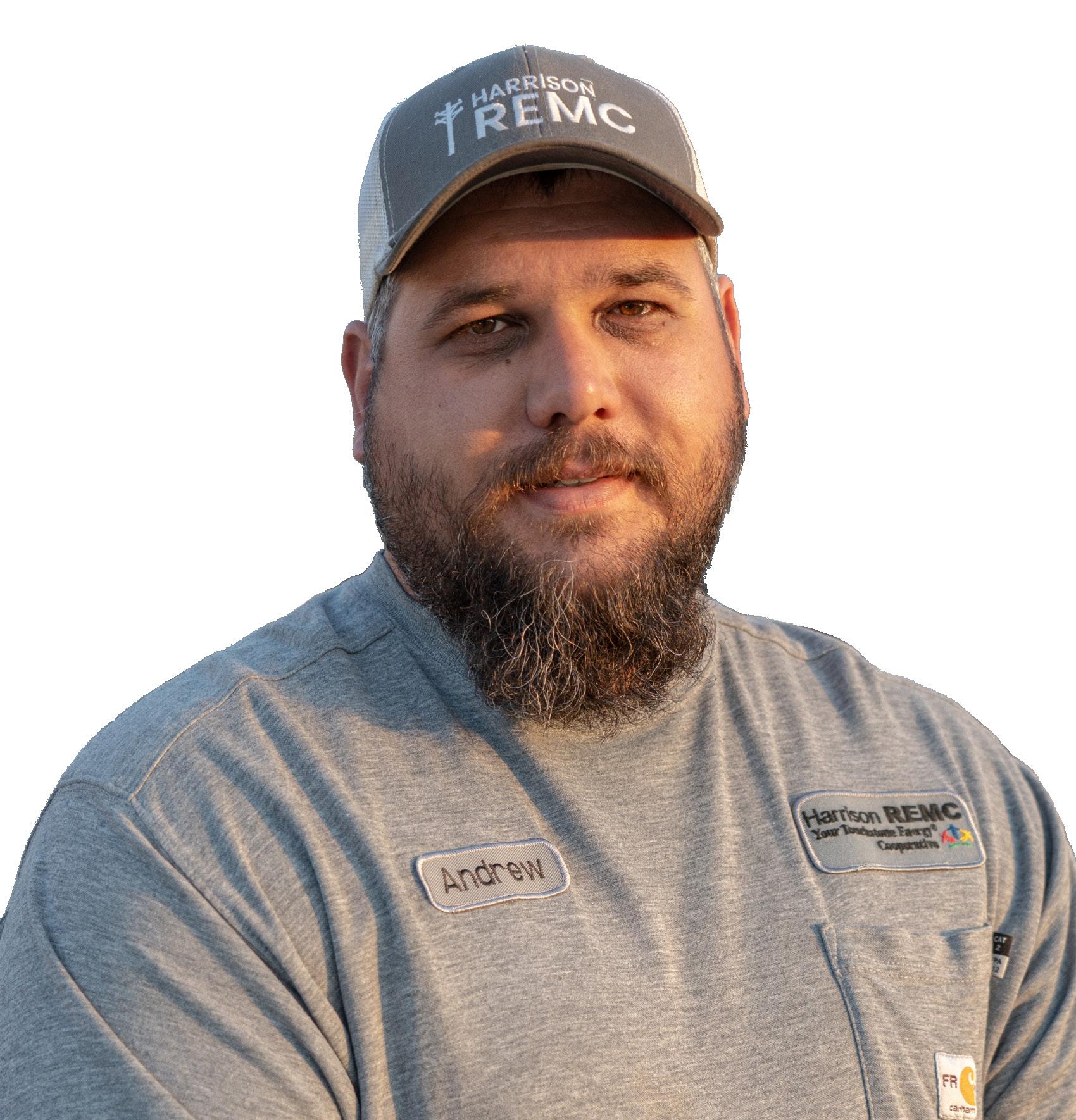
“I said, ‘Sir, can I help you with anything?’” Korte recalls. “He said, ‘I’m looking for my shoes.’ That was the first sign to me that we had an issue.”
It would not be the last.
While the rest of the Harrison REMC crew found issues on two poles, requiring them to kill a section of line and climb the poles to make the necessary repairs, Korte began to investigate the problem with the Shoeless Joe he had encountered.
During their conversation, the unidentified man asked the same question multiple times: “Who do you work for?”
“He kept asking that over and over again, so I knew something was wrong,” Korte said. “Then he started talking about how his feet hurt, and of course they did since he was out in socks.”
Korte then invited the man to sit in the truck and let the sun streaming
through the windshield warm him on a cool spring morning.
Meanwhile, Korte called Harrison REMC Dispatcher Dave Satori with a request.
“I said, ‘Hey, if you’re not too busy, could you try to find out who this guy is? He says he lives here, but I think he has dementia because he doesn’t remember his name.’”
Satori did just that, calling around to several houses in the subdivision and finally getting one of the neighbors to confirm that the man lived there, but they weren’t sure which house was his.
Eventually, the sheriff’s office was contacted, and an officer came out until they finally reached the man’s wife to resolve the situation.
“I enjoy helping people, preferably not when something terrible is going on, but it makes my day better to help somebody,” Korte said. “It makes me realize that it’s not just me I need to think about.”
SIMPLIFY
YOUR MONTHLY BILL
Set up autopay and never forget a monthly payment! Add Paperless Billing to cut the clutter!
Autopay
With autopay, you just enroll by filling out a simple form at duboisrec.com
By using autopay, money is withdrawn directly from your bank account to pay your electric bill each month. The automatic draft is processed on the 20th of each month. If this date falls on a holiday or weekend, the draft will occur the next business day. Once you sign up for the program you will still receive your bill each month, but it will state “Do Not Pay” on the statement in red.
Paperless Billing
One more way you can simplify your bill, and cut some paper cultter is to sign up for Paperless Biilling. Instead of a paper bill mailed to you each month, you can opt to have our system notify you via email, when your bill is ready each month. The electronic version of the bill looks just like the paper copy. You can also make a one-time payment, or set up recurring payments by using any existing payment option: by phone, SmartHub (at duboisrec.com) or dropping off your payment in the drive up box at the entrance of our parking lot.
SIGN UP NOW FOR AUTOPAY!
Follow theses simple steps to sign up for automatic bank draft, and have your electric bill paid each month from your designated bank account. This is a great way to save time and avoid late fees!
When you receive your monthly electric bill, please call the pay-by-phone number, located on the top left corner of your statement. (This is a 24/7 hotline for making payments.)
When prompted by our phone system enter your account number, which can also be found on your statement.
Make the payment and follow prompts on the automatic system to save your payment method for future recurring payments.
NOTE: There are no additional fees or charges for using this convenient service. You will still receive a statement each month indicating the amount that will be deducted from your bank account.
Dubois REC bills are printed near the first of the month and always due on the 20th of the month. If the 20th falls on a weekend or a holiday, the next business day will be used. 1 2 3
WHAT IS PAPERLESS BILLING?
It’s paperless — fewer bills in your mailbox result in less clutter. If you need a copy of your bill for your records, you can easily print one at any time.
It’s GREEN — paperless billing is better for the environment.
It’s convenient — review your account at any time. You will receive a monthly email notification when your bill is ready to view.
It’s secure — a unique user ID and password mean your account information is secure.
THE butterflies OF summer


There is a place along a snaky bend on Big Raccoon Creek where I wander in the heat of late summer. Like regular clockwork, I find treasure in that spot, some as golden as any pirate’s loot, and as fleeting as time.
Near the weathered trunk of a huge cottonwood that was deposited on the western bank by flood waters a decade ago, now high and dry above the usually shallow and green water of August, a hardy stand of milkweed and ironweed, goldenrod, white aster and woodland sunflowers, grows in the sand; it is blooming and bursting in full by mid-September, browning and windblown in October.
Although those wiry flowers draw a variety of insects, they also attract the last corps of butterflies we see until springtime. In this hot month, I walk there, kicking up dust and wiping the sweat from my brow with my forearm.
Like most things of value, I suppose, we take butterflies for granted. Year after year, we presume we’ll see monarchs and swallowtails, skippers
and fritillaries, painted ladies and sulphurs along our roads and in our gardens, not realizing that miracles are at play. We rake away our leaves too early, carelessly spray the weeds, and often mow and clear where we should leave well enough alone, yet butterflies persist through a nearpoetic balance between beauty and toughness. An example of that vigor comes as early as late February when I spot butterflies well before the last snows have fallen.
But along the creek, where I hear only the wind and the chatter of crows, I am privileged to watch the butterflies as they write the last chapters of their lives. Some are already faded and ragged, and when I see their fragility, I understand why most usually only survive about a week after they’ve unfolded their wet wings for the first time.
Although some monarchs persist into the fall — their migratory generation often has longer lifespans of six to nine months — by late August and through the autumn, it is the

buckeyes and cabbage whites, the hackberry emperors and yellow swallowtails, I see most of all. As the thistles and milkweed heads dry and release their cottony loads and the leaves begin the process of drying and dropping, butterflies congregate in wonderfully integrated gangs to stick their needlelike noses into the last nectars of the year. Yes, butterflies also pollinate, but it is an accidental gift they give to us.
Although we feel the heat of summer is still very much with us, and the year has a way yet to go, butterflies intuitively know their short lives are nearing an end. For that reason, I return to that seemingly ordinary place on the creek, for there I see something miraculous.
Mike Lunsford is a freelance columnist, feature writer, and photographer, primarily for the Terre Haute Tribune-Star and Terre Haute Living magazine. The author of seven books lives in Parke County with his wife, Joanie. Contact Lunsford at hickory913@gmail.com.




